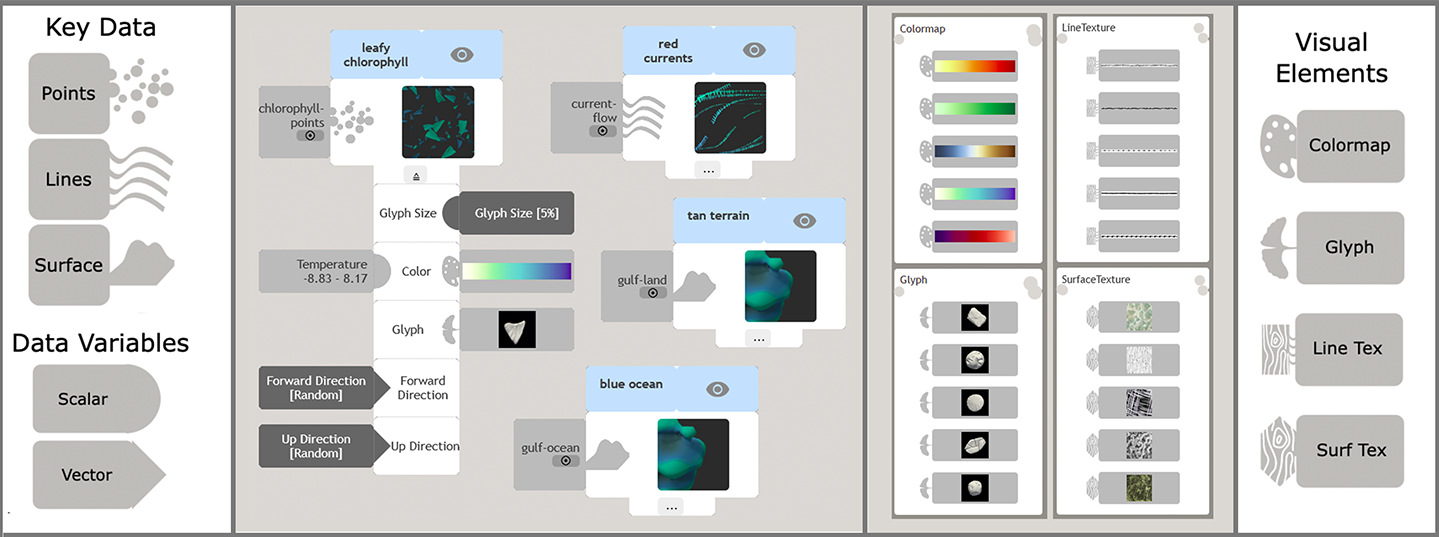Art Affect and Color Creating Engaging Expressive Scientific Visualization
ABR Interface

Artifact-Based Rendering is grounded in metaphors of printmaking, connecting our work in complex graphics processes with the practices of the artistic community. ABR layers glyphs, lines, and surfaces with color and shape the way a printmaker might approach image-making in their studio.
The user interface has five chief workable components:
- Cardinal Information: geometric representations of your information (points, lines, surfaces), loaded from VTK unstructured grid files, each slice of key data has associated scalar & vector variables
- Information Impressions: your "layers" of information in the visualization. Apply variables and visual elements to each information impression, and lookout man as they are composed in existent fourth dimension in your visualization.
- Data Palette: the panel on the left-hand side which displays information impressions and loaded variables for your information.
- Composition Panel: the primal window into which data impressions are dragged. Each set of data impressions + colormaps, glyphs, streamlines, etc. is called a "plate," sticking with the printmaking metaphors. Use this panel similar you would in Photoshop, adding visual elements as you meet fit. More information on this tin exist found further forth in this instructional guide.
- Design Palette: the panel on the right-paw side which displays all pattern options for the elements that contain your visualization.

Expanded Visualization Vocabularies

ABR enables artists and designers to leverage their practices in the visualization infinite. This capability includes expanding the visual vocabulary of scientific visualization—redefining the visual components used in data representations in a shift toward human- and nature-made glyphs, textures, lines and colors. This shift shortens the altitude betwixt data and the natural phenomena they represent and opens new possibilities for visually distinguishing and communicating intra-variate dynamics in complex visualizations.

Hand-drawn and painted lines and line-components in the eye of this image are applied to visualized Antarctic data, generated every bit data-mapped streamlines in ABR. The terminal visualizations can be seen on the far left and right of the paradigm to a higher place.

Here, hand-sculpted glyphs create a wide diversity of both shape and texture (center), which can exist imported as data-mapped objects into ABR and used in complex, multivariate visualizations, such as those shown in the left and right images above.

By drawing colour from natural imagery using ColorLoom, we can more effectively connect environmental information with the physical phenomena it represents, creating Affective visualizations that are intuitive and easy to parse. Here, the leftmost image shows an iPhone photograph taken of the New Mexico mural. The central prototype shows a palette of colors taken directly from the New Mexico landscape epitome. The rightmost image shows a visualization of Antarctic ocean data using these colors.
ABR Libraries
.png)
The ABR library catalogues glyphs, lines, colormaps, and textures created by Francesca Samsel, professional artist and co-PI of the Sculpting Vis Collaborative. Each of these assets is usable in the Antiquity-Based Rendering program. Click here to admission the online library of vis avails.
Applets

Infinite Line
.png)
Manus-fatigued and painted lines and line-components used to generate data-mapped streamlines in ABR.
Infinite Line brings the concrete artistic process into the visualization generation pipeline past allowing a user to sketch a line segment, upload an image of the sketch, and turn that sketch into a continuous, unbroken, patterned streamline. The output file can be dragged directly into ABR for immediate use.
Glyph Aligner
.png)
A broad variety of both shape and texture in paw-made objects, which are and so imported into ABR and mapped to information
Glyph Aligner like Infinite Line, connects the physical artistic procedure with the digital. When an artist creates a three-dimensional object, such as a small clay sculpture, they can 3D browse this object and drag it into Glyph Aligner. Glyph Aligner allows users to requite this 3D scan a directional quality. The output file can be dragged directly into ABR for immediate apply as a glyph.
ColorLoom

By drawing color from nature / natural imagery, using ColorLoom, we can more than effectively connect environmental data with the concrete phenomena it represents, creating Affective visualizations that are intuitive and easy to parse.
ColorLoom allows a user to generate custom colormaps with hues automatically pulled from imported images. This applet gives users looking to design a custom colormap a dynamic starting signal, and allows them to pull hues from imagery straight related to the dataset they are visualizing.
Texture Mapper
.png)
Texture Mapper shortens the infinite between the texture of the physical and digital worlds. A user may simply take a photograph of whatsoever surface and upload that photo to texture mapper. The program automatically extracts the texture of the photo and produces a file output that can exist dragged directly into ABR for immediate use equally a texture for information surfaces in a visualization.
Source: https://www.sculpting-vis.org/ABR.html
0 Response to "Art Affect and Color Creating Engaging Expressive Scientific Visualization"
Post a Comment